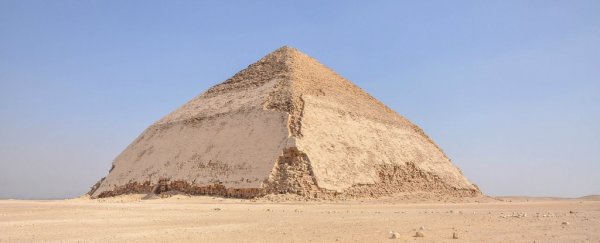The pyramids of Egypt have long been a source of archaeological wonder. There are countless movies and books about the possible treasures and traps hidden inside them, but fiction being fiction often glosses over the fact that exploring a pyramid is a lot of hard work.
Not only does it take a tonne of time, but it could also damage the ancient artefacts researchers are trying to study. Thankfully, scientists have been devising ways to get a look inside these structures without all of these headaches for years. Now, they finally have their solution: muons.
Instead of physically going inside the structure - at least, at first - why not scan the whole thing to see what's there?
Well, researchers from Cairo University's Scan Pyramid project are doing just that by, using cosmic particles known as muons that have the power to penetrate deeply into most materials and require only a few special instruments because they rain down naturally from the atmosphere above, reports Rossella Lorenzi for Discovery News.
"Just like X-rays pass through our bodies allowing us to visualise our skeleton, these elementary particles, weighing around 200 times more than electrons, can very easily pass through any structure, even large and thick rocks, such as mountains," mission co-director Mehdi Tayoubi said to Lorenzi.
The team's first successful scan was of the 4,500-year-old Bent Pyramid, which lies 40 km (25 miles) south of Cairo and was built by Pharaoh Sneferu.
To look inside, the team had to place a plate of emulsion film inside the pyramid's lower chamber to catch muons as they fell through the structure. After 40 days of exposure, the plates were collected and developed.
When the analysis was complete, the team had a complete map of the inside of the pyramid.
As Tayoubi explains in Lorenzi's report:
"From these plates, more than 10 million of muon tracks were analysed. We count the muons and according to their angular distribution we are able to reconstruct an image.
For the first time ever, the internal structure of a pyramid was revealed with muon particles. The images obtained clearly show the second chamber of the pyramid located roughly [18 metres] 60 feet above the lower one in which emulsions plates were installed."
This isn't the first time scientists have attempted to use muons to map the inside of the pyramids. Back in the 1960s, a scientist called Luis Alvarez used a similar technique to look for hidden chambers within Giza's Pyramid of Chephren, but the technology wasn't sensitive enough back then to reveal any real details about the internal struture of the pyramid.
The real advance this time is that the detectors in the emulsion plates being used by the Scan Pyramid project are a whole lot more sensitive, which means they can pick up a lot more information from those muons than ever before.
While this technique still requires archaeologists to enter the pyramids to place the emulsion plates, it's really the only way to check the entirety of the structure for hidden passageways without breaking into walls and potentially damaging extremely valuable pieces of history.
Next up for the team is the Great Pyramid of Khufu at Giza, which could have hidden chambers or passageways somewhere inside its sloped walls.
The team, which presented its findings in Cairo, is still working on making their system better and more accurate. There's no word yet on when the findings will be published, though the team is still in the midst of their study.
